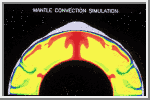|
COMETS EARTH JUPITER KUIPER BELT MARS MERCURY METEORITES NEPTUNE OORT CLOUD PLUTO SATURN SOLAR SYSTEM SPACE SUN URANUS VENUS ORDER PRINTS
PHOTO CATEGORIES SCIENCEVIEWS AMERICAN INDIAN AMPHIBIANS BIRDS BUGS FINE ART FOSSILS THE ISLANDS HISTORICAL PHOTOS MAMMALS OTHER PARKS PLANTS RELIGIOUS REPTILES SCIENCEVIEWS PRINTS
|
Related Document
Download Options
This image shows a computer simulation of processes in the interior of Mars that could have produced the Tharsis region. The color differences are variations in temperature. Hot regions are red and cold regions are blue and green, with the difference between the hot and cold regions being as much as 1000°C (1800°F). Because of thermal expansion, hot rock has a lower density than cold rock. These differences in density cause the hot material to rise toward the surface and the cold material to sink into the interior, creating a large-scale circulation known as mantle convection. This type of mantle flow produces plate tectonics on Earth. The hot, rising material tends to push the surface of the planet up, and the cold, sinking material tends to pull the surface down. These motions contribute to the overall topography of the planet. This deformation of the planet's surface is shown in gray along the outer surface of the planet in this image. The amount of deformation is highly exaggerated to make it visible here. The actual uplift in Tharsis is estimated to be about 8 kilometers (5 miles) at its center. This uplift also stretches the crust, forming features such as grabens and Valles Marineris. In addition, the hot, rising material may melt as it approaches the surface, producing volcanic activity. |
